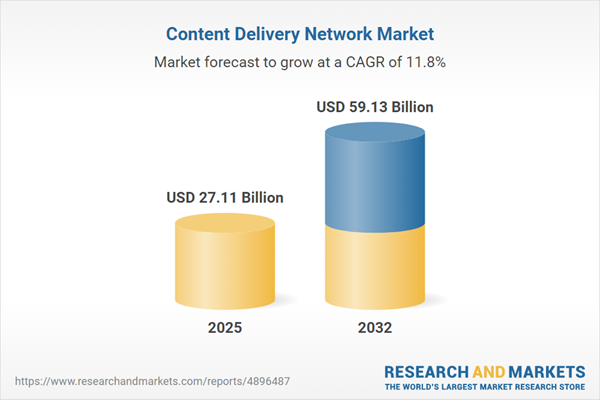Speak directly to the analyst to clarify any post sales queries you may have.
Content delivery networks have become central for enterprises prioritizing rapid, reliable, and protected digital delivery at scale. With heightened customer expectations and complex global digital operations, senior decision-makers must choose infrastructure partners positioned to support digital transformation with performance and resilience.
Market Snapshot: Content Delivery Network Market Size and Growth
The content delivery network (CDN) market is undergoing strong expansion, growing from USD 24.30 billion in 2024 to USD 27.11 billion in 2025 and expected to register a compound annual growth rate (CAGR) of 11.75%, ultimately reaching USD 59.13 billion by 2032. This significant growth reflects intensifying demand across industries, where digital modernization is accelerating. Organizations are placing strategic focus on CDN solutions to address rising content delivery needs, global reach, and shifting expectations for quality and seamless digital experiences.
Scope & Segmentation: Strategic Focus Areas in the Content Delivery Network Market
- Deployment Modes: Cloud-based (public or private), hybrid, and on-premise models allow organizations to balance scalability, control, and compliance with regulatory requirements.
- Organization Sizes: Large enterprises and small or medium-sized businesses require tailored CDN strategies aligned with their operational size, resource availability, and geographic distribution.
- Service Types: Solutions support live video streaming, video-on-demand, accelerated web content, and software distribution, enabling customization for a range of content formats and application needs.
- End User Verticals: Key sectors such as banking and financial services, e-commerce, retail, gaming, healthcare, and media & entertainment drive distinct security, performance, and customization demands in CDN deployment.
- Geographic Coverage: The study covers trends and adoption across major markets, including the Americas (with focus on the United States, Canada, and several Latin American countries), Europe, the Middle East and Africa, and Asia-Pacific (notably China, India, Japan, and others), revealing regional variations in adoption and infrastructure needs.
- Key Players Analyzed: The competitive landscape includes providers such as Akamai Technologies, Alibaba Group Holding, Amazon Web Services, AT&T, CDN77, CloudFlare, Comcast Technology Solutions, Deutsche Telekom AG, Edgio, Fastly, G-Core Labs, Google LLC, Imperva, IBM, Microsoft, Netlify, Rackspace Technology, Tata Communications, Tencent Holdings, and Verizon.
Key Takeaways for Senior Decision-Makers
- Content delivery networks are essential for reducing latency by distributing digital content closer to end-users, which ensures reliable performance and optimal user experience, particularly during periods of intense demand.
- The integration of edge computing and artificial intelligence within CDNs is enabling organizations to perform real-time data analysis and optimize network traffic, supporting dynamic requirements in areas including streaming, gaming, and key enterprise workloads.
- A shift toward hybrid and cloud-native architectures provides the flexibility to scale resources and support workload mobility, while also meeting the compliance needs of multiple jurisdictions.
- Sectors such as finance, healthcare, gaming, and e-commerce each present specialized requirements for security, regulatory compliance, and unique feature sets, influencing the level of CDN customization and vendor selection.
- Leading CDN vendors stand out by offering robust API-driven management capabilities, comprehensive analytics, and integrated security tools, allowing organizations to pursue both resilience and adaptability in fast-evolving digital contexts.
Tariff Impact: Navigating US Tariffs on Network Infrastructure
US tariffs on networking hardware have introduced added complexity to cost structures and supply chains for CDN providers. In response, organizations are diversifying vendors, strengthening regional manufacturing alliances, and adopting hardware-independent software strategies to minimize risk. These measures support continued service availability and operational agility in uncertain geopolitical circumstances.
Methodology & Data Sources
Market insights use a hybrid methodology that combines direct interviews with technology experts and secondary research from reliable sources, including white papers and regulatory analysis. Data triangulation and expert validation ensure accuracy and depth in evaluating sector trends and operational challenges in the CDN market.
Why This Report Matters: Strategic Benefits for Executives
- Enables informed investment and procurement decisions through detailed analysis of technology trends and regional adoption patterns in content delivery networks.
- Supports risk management and operational planning, with robust insight into tariff implications, vendor differentiation, and supply chain diversity strategies.
- Provides a strategic guide for embedding performance, compliance, and scalability into enterprise CDN deployments as digital initiatives expand.
Conclusion
Strategic adoption of advanced CDN solutions empowers organizations to deliver secure, high-quality digital experiences worldwide. This analysis equips leadership with the insights required to enhance infrastructure and sustain business advantage.
Additional Product Information:
- Purchase of this report includes 1 year online access with quarterly updates.
- This report can be updated on request. Please contact our Customer Experience team using the Ask a Question widget on our website.
Table of Contents
3. Executive Summary
4. Market Overview
7. Cumulative Impact of Artificial Intelligence 2025
List of Figures
Samples

LOADING...
Companies Mentioned
The key companies profiled in this Content Delivery Network market report include:- Akamai Technologies, Inc.
- Alibaba Group Holding Limited
- Amazon Web Services, Inc.
- AT&T Inc.
- CacheNetworks, LLC
- CDN77 by DataCamp Limited.
- CDNetworks Inc.
- CloudFlare, Inc.
- Comcast Technology Solutions
- Deutsche Telekom AG
- Edgio
- Fastly, Inc.
- G-Core Labs S.A.
- Google LLC by Alphabet Inc.
- Imperva, Inc.
- International Business Machines Corporation
- KeyCDN by proinity LLC
- Kingsoft Corporation, Ltd.
- Microsoft Corporation
- Netlify, Inc.
- Rackspace Technology
- Shift8 by Star Dot Hosting, Inc.
- Tata Communications Group
- Tencent Holdings Ltd.
- Verizon Communications, Inc.
Table Information
| Report Attribute | Details |
|---|---|
| No. of Pages | 198 |
| Published | October 2025 |
| Forecast Period | 2025 - 2032 |
| Estimated Market Value ( USD | $ 27.11 Billion |
| Forecasted Market Value ( USD | $ 59.13 Billion |
| Compound Annual Growth Rate | 11.7% |
| Regions Covered | Global |
| No. of Companies Mentioned | 26 |









